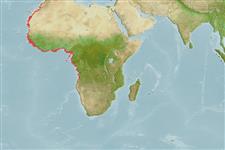Classification / Names
Common names from other countries
Main reference
Size / Weight / Age
Max length : 30.0 cm TL male/unsexed; (Ref. 57395); common length : 23.0 cm TL male/unsexed; (Ref. 3660)
Length at first maturity
Lm 14.8 range ? - ? cm
Environment
Marine; brackish; benthopelagic; depth range 10 - 100 m (Ref. 57395), usually 15 - 80 m (Ref. 26999)
Climate / Range
Tropical, preferred 25°C (Ref. 107945); 35°N - 16°S, 19°W - 14°E (Ref. 54289)
Distribution
Short description
Dorsal
spines
(total): 10 - 13;
Dorsal
soft rays
(total): 11-14;
Anal
spines: 3;
Anal
soft rays: 9 - 10. Diagnosis: body oblong and compressed; dorsal profile slightly and regularly convex; snout shorter than eye diameter (Ref. 57395). Mouth large, oblique (Ref. 5377, 57395) and protrusible (Ref. 57395). Lower jaw slightly prominent; 2 anterior pores on chin, followed by a median pit bearing openings of two large pores (Ref. 57395). Eyes large (Ref. 5377). Dorsal fin deeply notched; caudal fin deeply forked; scales ctenoid on body and head (Ref. 57395).
Coloration: back olivaceous, sides silvery to white; dark spot at angle of opercle; sometimes several small, dark spots on dorsal-fin base (Ref. 57395). Fins grey (Ref. 5377).
IUCN Red List Status (Ref. 115185)
Threat to humans
Harmless
Human uses
Fisheries: highly commercial
More information
ReferencesAquacultureAquaculture profileStrainsGeneticsAllele frequenciesHeritabilityDiseasesProcessingMass conversion
Tools
Special reports
Download XML
Internet sources
Estimates of some properties based on models
Phylogenetic diversity index
PD50 = 1.0000 many relatives (e.g. carps) 0.5 - 2.0 few relatives (e.g. lungfishes)
Trophic Level
3.0 ±0.44 se; Based on food items.
Resilience
Medium, minimum population doubling time 1.4 - 4.4 years (K=0.29-0.4; tmax=7;)
Vulnerability
Low to moderate vulnerability (33 of 100)
Price category
